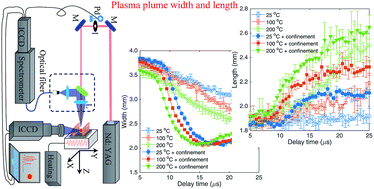Characteristics of laser-induced aluminum plasma plumes after increasing sample temperature and spatial confinement
Abstract
In this paper, an Nd:YAG laser was used to ablate an aluminum target and produce laser-induced plasma. A heating stage and two parallel plates were used to heat the target and confine the plasma. As determined by measuring the spectral emission, the combination of spatial confinement and an increased target temperature had stronger enhancement effects compared with the cases of spatial confinement or an increased target temperature alone. In addition, the effect of increasing the target temperature and spatial confinement on plasma expansion dynamics was investigated by time-resolved plume morphology. By capturing the images of the plasma plume during its expansion, it was easier to understand the enhanced mechanism of plasma emission. When the target was heated, the plasma plume expanded faster and became narrower. Moreover, when the spatial confinement was combined with the increased target temperature, the reflected shockwave confined the expansion of the plasma plume in the lateral direction, which led to further compression of plasma in the lateral direction and further expansion of the plasma plume in the axial direction compared with the case without spatial confinement.



 Please wait while we load your content...
Please wait while we load your content...